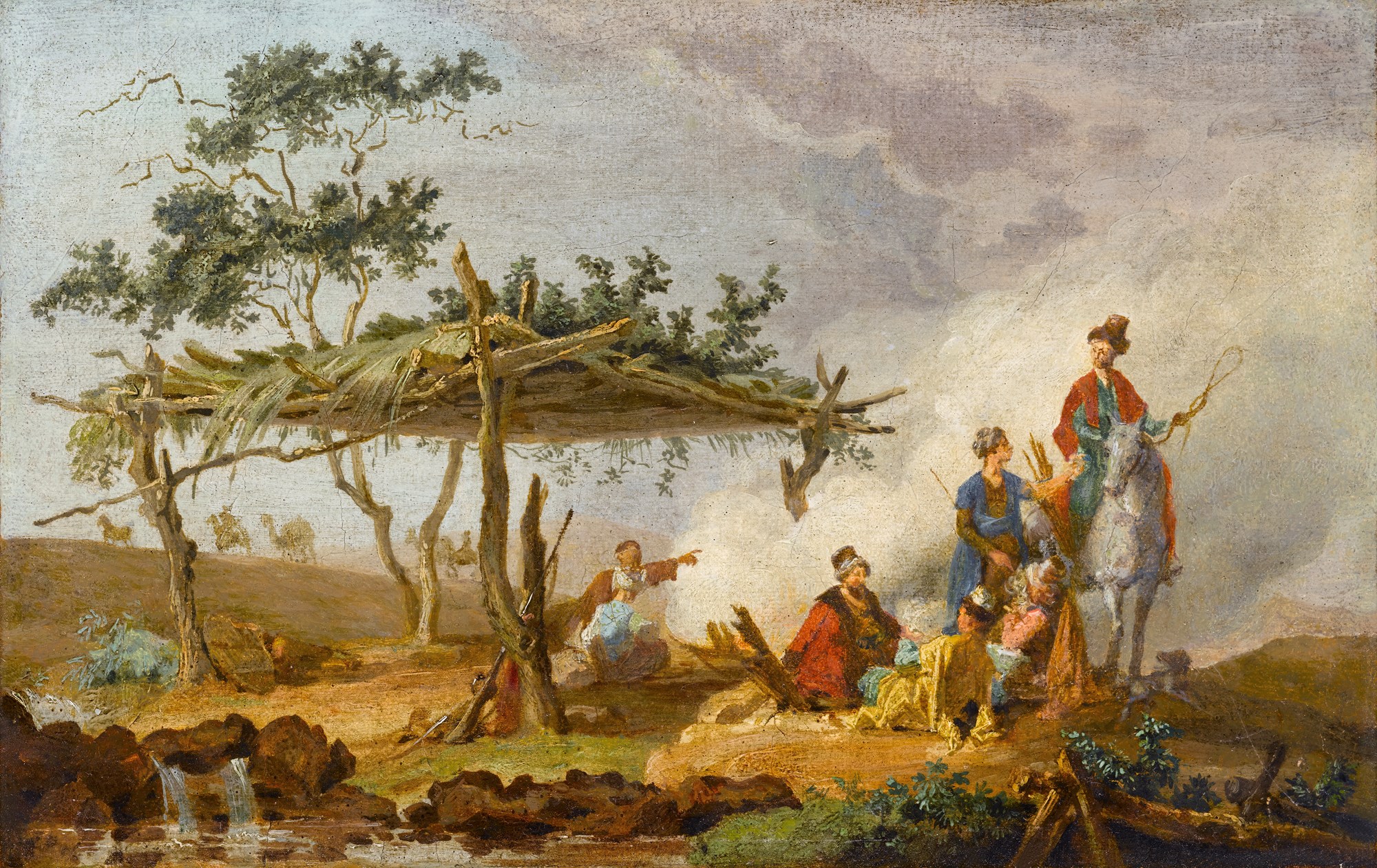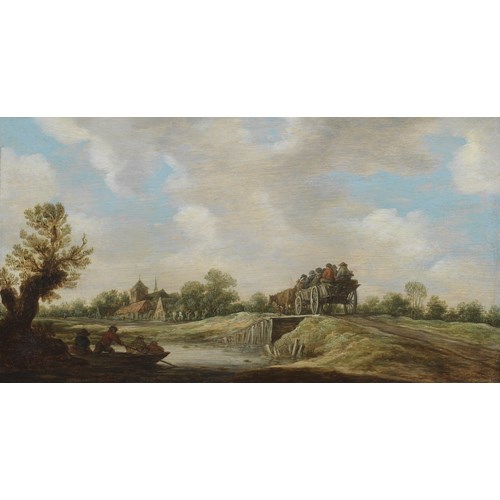Jean-Baptiste Hilair
A Roadside Coffeehouse between Milas and Bodrum, Turkey
Epoque 1750-1850, 18th century
Origine Turkey
Medium Oil on paper, Laid down on canvas
Dimension 16.9 x 27.3 cm (6⁵/₈ x 10³/₄ inches)
In 1776 Hilair travelled to the Mediterranean alongside Marie-Gabriel-Florent-Auguste, Comte de Choiseul-Gouffier (1752-1817). Identified as a voyageur-philosophe in his official éloge, the Comte was not only a passionate antiquarian but also wished to examine and explain the political situation in the Aegean between the Ottoman Empire and Imperial Russia.¹ His subsequent book, Voyage Pittoresque de la Grèce, ‘was a model of contemporary travel literature’, which was illuminated by engravings after paintings by Hilair, of which the present work is an excellent example.²
In Voyage Pittoresque de la Grèce the Comte discusses the scene in unusual detail.³ It depicts a roadside coffeehouse that the travellers encountered on their journey between Milas and Bodrum, where a Tartar messenger has paused for refreshment. This was a key point on the Comte’s exploration of ancient sites, as it is in the historic south-western Aegean region of modern Turkey. Bodrum was formerly known as Halicarnassus, site of the Mausoleum of Mausolus, one the Seven Wonders of the World. As the ancient capital of Caria, Milas is similarly rich in history, with a remarkable twenty-seven archaeological sites of note. In his text, the Comte praises Hilair’s ability to faithfully capture the detail of the scene, and exotic details such as the figures’ dress, the camels in the background, and the ramshackle nature of the coffeehouse which would have fascinated and appealed to a contemporary French audience. In a similar vein, Hilair places a camel prominently in the foreground of the Louvre’s Oriental Landscape.
Auguste Boppe, in his Les Peintres du Bosphore, considered Hilair to be the artist who best understood the Levant amongst the early Orientalists.⁴ As already mentioned he was trained by Le Prince, and although the present work reflects his teacher’s influence, especially its concern with conveying an exotic and alien culture, it is unquestionably in Hilair’s distinctive style. This is particularly evident in details such as Hilair’s treatment of trees, where the thin, sinuous branches can be seen both in this Turkish work, and his painting from his French period, such as the Louvre’s La Lecture. Hilair’s illustrations to Voyage Pittoresque de la Grèce, contributed to the book’s huge success, and so when the Comte later became the French ambassador in Istanbul, he continued to employ Hilair. He also contributed illustrations for Tableai General de l’Empire Ottoman, by the Armenian Mouradgea D’Ohsson, and as Gaston Migeon has written, his work demonstrates a devotion to accuracy in addition to an unusual sensitivity to the beauties of the East.⁵
¹ Dacier, B-J., ‘Notice historique sur la vie et les ouvrages de M. Le comte de Choiseul-Gouffier’, in Histore et memoires de l’Institut royale de France, Académie des Inscriptions et Belles-Lettres VII (Paris, 1824), pp. 175-176.
² Harris, W. V., Rethinking the Mediterranean (Oxford University Press, Oxford, 2005), p.263.
³ Comte de Choiseul-Gouffier, Voyage Pittoresque de la Grèce, (Paris, 1782), vol I, p.152.
⁴ Boppe, A., Les Peintres du Bosphore au Dix-Huitième Siècle (Hachette, Paris, 1911), p.vi.
⁵ Migeon, G.‚ 'Peintres-Voyageurs en Turquie au XVIII Siècle: J.-B. Hilair,' in Syria (vol 5, no 3, 1924), p.256.
Epoque: 1750-1850, 18th century
Origine: Turkey
Medium: Oil on paper, Laid down on canvas
Signature: Engraved: Jean-Baptiste Liénard, Route de Melasso à Boudroun.
Dimension: 16.9 x 27.3 cm (6⁵/₈ x 10³/₄ inches)
Provenance: Anonymous sale, Sotheby’s, Paris, 25th June 2008, lot 91, as Jean-Baptiste Le Prince;
with Agnews, London, by whom exhibited at TEFAF, Maastricht, as Jean-Baptiste Le Prince.
Literature: Marie-Gabriel-Florent-Auguste, Comte de Choiseul-Gouffier, Voyage Pittoresque de la Grèce, (Paris, 1782), vol I, pp. 151-152, pl. 94.
Plus d'œuvres d'art de la Galerie









